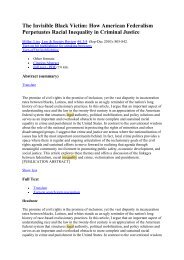Ski – resort and regional development: profile of visitors ... - E-Journal
Ski – resort and regional development: profile of visitors ... - E-Journal
Ski – resort and regional development: profile of visitors ... - E-Journal
Create successful ePaper yourself
Turn your PDF publications into a flip-book with our unique Google optimized e-Paper software.
A tale <strong>of</strong> two caravan parks: friendship, community <strong>and</strong> the freedom thing<br />
The concept <strong>of</strong> ‘community’ is not unproblematic. As Raymond Williams (1983) noted in<br />
Keywords: ‘Community can be the warmly persuasive word to describe an existing set <strong>of</strong><br />
relationships, or the warmly persuasive word to describe an alternative set <strong>of</strong> relationships.<br />
What is most important, perhaps, is that unlike all other terms <strong>of</strong> social organization (state,<br />
nation, society, etc.) it never seems to be used unfavourably, <strong>and</strong> never to be given any positive<br />
opposing or distinguishing term’ (1983, p76). However, this does not alter the general<br />
argument that focal leisure activities <strong>of</strong>fer opportunities to become involved in a community<br />
<strong>of</strong> interest.<br />
Literature on the psychological concept <strong>of</strong> a sense <strong>of</strong> community is quite well developed<br />
(McMillan & Chavis, 1986; McMillan, 1996). McMillan’s (1996) theory <strong>and</strong> definition which<br />
developed from his earlier work with Chavis, proposes that sense <strong>of</strong> community is composed<br />
<strong>of</strong> four defining elements: spirit; trust; trade; <strong>and</strong> art. For McMillan, these elements are linked<br />
in a self-reinforcing circle.<br />
Part <strong>of</strong> the significance <strong>of</strong> the attraction to a sense <strong>of</strong> community within the caravan park is<br />
that for many urban dwellers, a sense <strong>of</strong> community is something that has been lost from our<br />
everyday lives (Parker, 2004). We live close to each other in crowded cities but somehow<br />
remain socially isolated from our neighbours. Recent media reports in Sydney, Australia<br />
highlighted five instances within a ten day period in which people had died alone in their<br />
homes in high density urban areas <strong>and</strong> were not discovered by their neighbours for many<br />
months (El-Chami, 2006; Australian Broadcasting Corporation, 2006; Kent, 2006). The<br />
undiscovered deaths were attributed to a lack <strong>of</strong> a sense <strong>of</strong> community <strong>and</strong> the reluctance <strong>of</strong><br />
neighbours to look out for each other (Kent, 2006).<br />
While theoretical debate continues on how to remedy the situation, urban sociologists have<br />
long recognised that cities have not been planned with a sense <strong>of</strong> community in mind (Grant,<br />
2006; Parker, 2004). Urbanism as a way <strong>of</strong> life “with its impersonality, anonymity <strong>and</strong> world<br />
<strong>of</strong> strangers” has been developed with the interests <strong>of</strong> business <strong>and</strong> industry in mind, not the<br />
sociable interests <strong>of</strong> its citizens (Wearing, 1998, p.128). Critical theorists argue that this<br />
situation is a result <strong>of</strong> an imbalance in power relations between big business <strong>and</strong> the rest <strong>of</strong><br />
the community (Bessant & Watts, 2002; Parker, 2004).<br />
The above view is manifested in the design <strong>and</strong> use <strong>of</strong> the typical urban streetscape. The<br />
current generation <strong>of</strong> children growing up in urban Australia generally do not play with their<br />
child neighbours in the street as their parents <strong>and</strong> gr<strong>and</strong>parents may have done during their<br />
own childhood years. Nor do our children ride their bicycles around their local suburb unless<br />
they are accompanied by a responsible adult. It is not considered safe for them to do so. The<br />
combination <strong>of</strong> the dangers <strong>of</strong> traffic <strong>and</strong> “stranger danger” keep children isolated inside their<br />
own homes. Our homes provide refuge as well as revealing our deep need for security, image<br />
<strong>and</strong> identity (Grant, 2006). The design <strong>of</strong> our communities <strong>and</strong> the availability <strong>of</strong> public<br />
space do not encourage casual socialising with our friends <strong>and</strong> neighbours (Putnam, 2000,<br />
Tourism Today - Fall 2007 - Full Paper<br />
11














